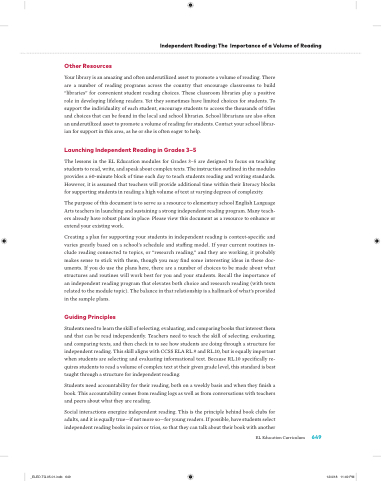Page 673 - EL Grade 5 Teacher Guide
P. 673
Independent Reading: The Importance of a Volume of Reading
Other Resources
Your library is an amazing and often underutilized asset to promote a volume of reading. There are a number of reading programs across the country that encourage classrooms to build “libraries” for convenient student reading choices. These classroom libraries play a positive role in developing lifelong readers. Yet they sometimes have limited choices for students. To support the individuality of each student, encourage students to access the thousands of titles and choices that can be found in the local and school libraries. School librarians are also often an underutilized asset to promote a volume of reading for students. Contact your school librar- ian for support in this area, as he or she is often eager to help.
Launching Independent Reading in Grades 3–5
The lessons in the EL Education modules for Grades 3–5 are designed to focus on teaching students to read, write, and speak about complex texts. The instruction outlined in the modules provides a 60-minute block of time each day to teach students reading and writing standards. However, it is assumed that teachers will provide additional time within their literacy blocks for supporting students in reading a high volume of text at varying degrees of complexity.
The purpose of this document is to serve as a resource to elementary school English Language Arts teachers in launching and sustaining a strong independent reading program. Many teach- ers already have robust plans in place: Please view this document as a resource to enhance or extend your existing work.
Creating a plan for supporting your students in independent reading is context-speci c and varies greatly based on a school’s schedule and sta ng model. If your current routines in- clude reading connected to topics, or “research reading,” and they are working, it probably makes sense to stick with them, though you may nd some interesting ideas in these doc- uments. If you do use the plans here, there are a number of choices to be made about what structures and routines will work best for you and your students. Recall the importance of an independent reading program that elevates both choice and research reading (with texts related to the module topic). The balance in that relationship is a hallmark of what’s provided in the sample plans.
Guiding Principles
Students need to learn the skill of selecting, evaluating, and comparing books that interest them and that can be read independently. Teachers need to teach the skill of selecting, evaluating, and comparing texts, and then check in to see how students are doing through a structure for independent reading. This skill aligns with CCSS ELA RL.9 and RL.10, but is equally important when students are selecting and evaluating informational text. Because RL.10 speci cally re- quires students to read a volume of complex text at their given grade level, this standard is best taught through a structure for independent reading.
Students need accountability for their reading, both on a weekly basis and when they nish a book. This accountability comes from reading logs as well as from conversations with teachers and peers about what they are reading.
Social interactions energize independent reading. This is the principle behind book clubs for adults, and it is equally true—if not more so—for young readers. If possible, have students select independent reading books in pairs or trios, so that they can talk about their book with another
EL Education Curriculum 649
_ELED.TG.05.01.indb 649
12/4/18 11:49 PM


